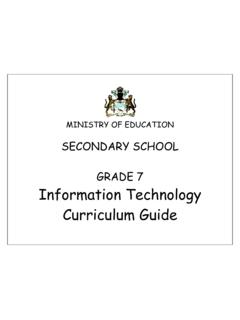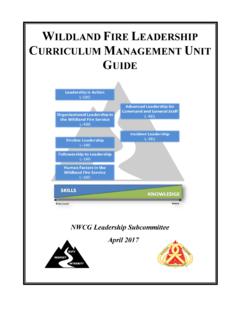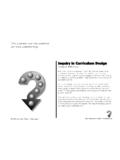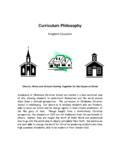Transcription of Incorporating Skill Standards into Curriculum: A …
1 Incorporating Skill Standards into curriculum : A User s guide For Community and Technical Colleges Applying for Program Recognition from the Texas Workforce Investment Councili Table of Contents Introduction .. 1 Understanding Skill Standards .. 2 What do Skill Standards Look Like? What do Recognized Skill Standards Look Like? .. 3 What do Conditionally Recognized Skill Standards Look Like? .. 8 Incorporating Skill Standards Elements into Workforce Education curriculum .. 14 Appendix .. 25 1 Introduction Incorporating Skill Standards into curriculum : A User s guide (User s guide ) is designed to help community and technical colleges understand and integrate Skill Standards content into workforce education programs. Skill Standards are an ideal source of the industry-driven skills , knowledge and outcomes required in a competency-based curriculum in Texas. By documenting the incorporation of Skill Standards in a program, colleges demonstrate to employers that they are teaching the industry s Skill and knowledge requirements.
2 The User s guide helps to translate Skill Standards elements and terminology into curriculum components through suggestions and examples, without prescribing a standardized approach. It leaves curriculum development to the experts college faculty and administrators. The following section, understanding Skill Standards , defines Skill Standards and explains the two types of Standards . The rest of the guide is divided into two main sections: 1) What do Skill Standards look like describes the elements and format of recognized and conditionally recognized Skill Standards . 2) Incorporating Skill Standards elements into workforce education curriculum suggests how the Standards elements may be used to develop curriculum components. For examples of community and technical colleges that have integrated Skill Standards into their curricula, see the recognized programs page of the Texas Skill Standards website at: 2 Understanding Skill Standards What are Skill Standards ? Skill Standards tell us what workers do on the job and how well they must perform to succeed in the workplace.
3 Skill Standards also identify the skills and knowledge required to do the work. Skill Standards are developed for an occupational area. A group of employers within an industry, often a professional or trade association, leads the development effort. Front-line workers those who actually perform the job and their immediate supervisors define the Skill Standards . The Standards are then validated with workers across the industry to ensure the content is representative of the work it describes. Recognized vs. Conditionally Recognized The Texas Workforce Investment Council (TWIC) recognizes industry Skill Standards that meet established development criteria and stores them in the Texas Skill Standards website repository. Two categories of recognition are granted to Skill Standards : recognized and conditionally recognized. To be granted either category of recognition, an industry group must provide evidence that both the Skill Standards content and development process are valid and reliable.
4 To be awarded the recognized category, the development and validation process must be conducted with Texas statewide industry representation. In addition, the occupational data must be organized into the Texas Skill Standards elements and format. The recognized category applies primarily to Skill Standards developed for occupations where no Standards previously existed. The conditionally recognized designation is granted to Skill Standards developed and validated by industry outside the state of Texas. These Standards are not required to be formatted into the Texas elements. This category applies to Skill Standards that have already been developed for an occupation. The two categories of recognition simply distinguish the two types of Skill Standards . Conditional recognition does not indicate a lesser or temporary status for Standards that will eventually be upgraded to recognition status. Standards in either category have been fully recognized, are equal in value, and are valid, reliable and representative of the work they describe.
5 Different Formats All recognized Skill Standards look the same. They are composed of the same seven elements organized into a standard format. Conditionally recognized Skill Standards vary in elements and format depending on the industry group that developed them. The next section illustrates the elements and format of recognized and conditionally recognized Skill Standards . How to integrate those elements into the curriculum is addressed in the last section, Incorporating Skill Standards elements into workforce education curriculum . What Do Skill Standards Look Like?3 What Do Recognized Skill Standards Look Like? All recognized Skill Standards are composed of seven elements. Three work-oriented elements describe the work being performed: Critical work functions Key activities Performance criteria Three worker-oriented elements describe the skills and knowledge required to perform the work: Occupational skills , knowledge and conditions Academic knowledge and skills Employability knowledge and skills The last element advises on the best method to evaluate performance in the work: Statement of assessment Each element is described in greater detail below and illustrated with the Geographic Information Systems (GIS) Technician Skill Standards .
6 The GIS Technician Skill Standards represent an occupational area encompassing a cluster of related job titles such as environmental science and protection technicians; surveying and mapping technicians; and life, physical, and social science technicians. Every set of recognized Skill Standards also has a key purpose. The key purpose summarizes the work-related goal of the occupational area, as in the GIS Technician example on the following page. All seven Skill Standards elements are related to the key purpose. Element 1: Critical Work Function First, Skill Standards break down an occupation into its principal responsibilities or critical work functions. A number of these work functions are required to accomplish the key purpose of the occupation. Each critical work function is assigned a discrete number. In the example of the GIS Technician Skill Standards on the following page, 10 critical work functions are needed to achieve the key purpose. 4 Occupational Title: Geographic Information Systems (GIS) Technician Key Purpose: Creates software and data solutions to assist in the visualization, measurement, and analysis of features or phenomena that occur on earth that integrates acquisition, modeling, analysis, and management of spatially referenced data.
7 Critical Work Functions 1. Create and/or acquire GIS data. 2. Create image data. 3. Maintain GIS data. 4. Conduct spatial/non-spatial analysis. 5. Generate GIS products. 6. Develop software applications. 7. Manage GIS data. 8. Provide technical support. 9. Perform administrative tasks. 10. Pursue professional development. Element 2: Key Activity Each critical work function is divided into several major tasks, or key activities. The key activities are listed sequentially with a numbering system that links them to the relevant critical work function ( , , or , , etc.). In this system, the first number represents the critical work function and the second number indicates the key activity. For the GIS Technician Skill Standards , four key activities are required to perform critical work function 2, as illustrated in the example below. Occupational Title: GIS Technician Critical Work Function 2. Create image data. Key Activities Scan hard copy images into digital format.
8 Geo-reference digital imagery. Rectify images to meet data Standards . Perform image analysis (classification). Element 3: Performance Criteria What does successful performance of a key activity look like? To what standard must workers perform? These questions are answered with the performance criteria. The performance criteria specify the type, quality and level of output (demonstrable behavior or product) required to successfully perform the key activity. The performance criteria are also numbered sequentially ( , , , etc.). Again, the first and second numbers indicate the related critical work function and key activity, respectively, while the last number represents the performance criterion. 5 In the example below, six performance criteria indicate the Standards to which a GIS technician must perform key activity Occupational Title: GIS Technician Critical Work Function 2. Create image data. Key Activity Performance Criteria Perform image analysis (classification).
9 Outputs of the thematic raster layer should keep the commission and omission errors within acceptable limits and should include class values, class names and/or color table. Vector data is created based on classification analysis. Image classification conforms to the project Standards . Different types of surfaces are currently identified from remote sensing bands. A field check of what was classified verifies that surfaces are correctly identified. New vector layer derived from the reclassification accurately reflects field phenomena. Element 4: Occupational skills , Knowledge and Conditions The occupational skills , knowledge and conditions are those skills and knowledge specific to the work context and the tools, resources and equipment needed to perform the key activity and its related performance criteria. An example of occupational skills , knowledge and conditions for key activity and its associated performance criteria is: Occupational Title: GIS Technician Critical Work Function 2.
10 Create image data. Occupational skills , Knowledge & Conditions Key Activity Performance Criteria Occupational skills & Knowledge Conditions Perform image analysis (classification) Outputs of the thematic raster layer should keep GIS principles Photogrammetry Database skills Computer skills Keyboarding skills Personal computer GIS software Image display and manipulation software Geospatial imaging products Elements 5 and 6: Academic and Employability Knowledge and skills The academic knowledge and skills and the employability knowledge and skills are the basic, underlying competencies that enable a worker to perform the key activities. Academic and employability knowledge and skills are similar to the SCANS competencies1. There are four academic, and 13 employability, knowledge and skills , listed on the next page: 1 The Secretary s Commission on Achieving Necessary skills (SCANS) identifies entry-level workforce skills described in a 1991 Department of Labor report, What Work Requires of Schools.





